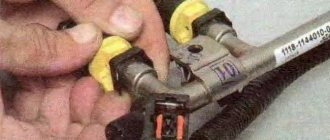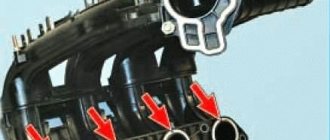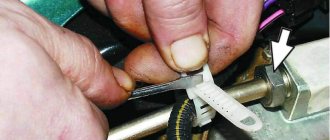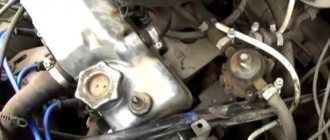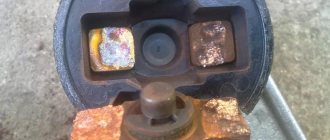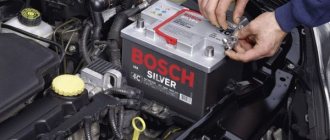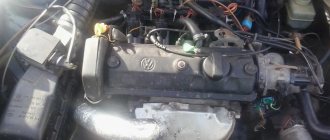More than once, Lada Kalina car owners have encountered the concept of a car starting up and immediately stalling. There are few reasons for this phenomenon, but they can create discomfort, and the car may simply not start at the most necessary moment.
Video with a solution to the “double start” problem on the Lada Kalina (starts and immediately stalls):
The video material will tell you why Kalina starts and immediately stalls, the causes of the malfunction and methods for eliminating it
Kalina stalls on a cold engine
Good day!
Tell me what to do, my Kalina has trouble starting when it’s cold. Sometimes you have to start it several times, the revs are low and it doesn’t hold. You have to apply more gas, after which they level out. What could be the problem? I'll go for diagnostics as a last resort if I can't figure it out myself. I don’t even know; without diagnostics it will be difficult to determine the cause. You need to measure the pressure in the fuel rail, check the spark plugs, clean the throttle, check the sensors. Too much work
Buy the simplest on-board computer and install it on your Kalina Delov...
I will prioritize:
- replace the spark plugs;
- replace high-voltage wires;
- check the temperature sensor;
- check and, if necessary, replace the TPS;
Somehow like this
Your Kalina doesn't start well when it's cold, I'm familiar with this problem. He himself spent a lot of time and effort to resolve the unpleasant situation. Looking ahead, I’ll say that you can give strength to the engine of your car yourself, at least I personally managed to do it. Now I’ll tell you in order what I checked, what I replaced so that Kalina would start normally.
Symptoms of a problem
- The first sign indicating a breakdown of the fuel pump will be a banal refusal of the engine to start. Of course, such an indicator as an unstarted car is very general. In this case, it is worth checking the spark plugs, which may become oily and not produce a spark and the ECU.
- The second point is the pressure of the fuel system. If the fuel pump is OK, it creates a pressure of 3.2 bar. The fuel rail is characterized by the following indicators:
- for a volume of 1.5 l – from 285 to 325 kPa,
- for a volume of 1.6 l - from 375 to 390 kPa.
- A very common problem is when the signal does not reach the fuel pump after ignition. When you turn the key, you usually hear a slight vibration from the fuel pump, but here it doesn’t happen. Most likely the wiring has failed. We'll have to call her and figure out what's what.
- The engine is tripping. Like reason number one, this indicator is not a benchmark. It is believed that the signs of a malfunction of the VAZ 2114 fuel pump are represented by other obvious causes of malfunctions. However, if the fuel pump is not working properly, the engine begins to jerk (which is natural, fuel combustion in the cylinders occurs incorrectly), and operate intermittently out of the blue.
- The engine may jerk even before starting or at low speeds. This reason is closer to the truth: either the fuel pump or its mesh – a low-purity filter – is not working.
The fuel module, which includes the pump itself, is expensive - from 2,000 to 3,000 rubles. The inept owners of the fourteenth buy it entirely (together with the filter, fuel level sensor, float and intake chamber) and install it to replace the deceased.
In fact, the price of a VAZ 2114 fuel pump is only 700-1000 rubles, you only need to take and install it, the rest of the module almost always remains intact.
Just don’t immediately run to the spare parts store and buy a new one! There are plenty of reasons for the breakdown, including those that may lie in the power system. Here are the main ones:
- Fuel pump fuse VAZ 2114
- Fuel pump relay VAZ 2114
- Poorly secured mass of the VAZ 2114 fuel pump
- Fuel pump motor VAZ 2114
- Contacts of the fuel pump system VAZ 2114
- The fuel pump itself
We recommend: Fuel pressure regulator VAZ 2114
All these spare parts can break and stop the normal operation of the fuel module system. In fact, the fuel pump is the part of the fuel system that passes gasoline under pressure. The mechanism is complicated, we will understand it step by step.
The Lada Kalina car engine stalls when idling
One of the components that causes the Kalina engine to stop idling is the idle speed regulator (IAC), which becomes clogged with sticky dirt. As a result, its needle remains in the closed position, and the combustible mixture stops flowing into the engine cylinders.
In order to remove the IAC from its installation site and clean the needle using a special solvent or at least alcohol (liquid should not get inside), you must first warm up the engine, then disconnect the wires from it and immediately turn off the engine. In this case, the IAC needle (after removing it) will stick out above the plane of the connector and will be easier to clean. In this way, you can reanimate the IAC, but if this does not help, then it will have to be replaced. There are cases when voltage is simply not supplied to the IAC; in this case, you will have to check the contacts in the plug connectors and the integrity of the wires going to it.
The second problem with the engine idling may be the throttle sensor, which fails due to fairly rapid wear of the resistive layer of the variable resistor, since this layer does not like moisture and dust.
Electronic components
Perhaps the most common reason that a car starts and immediately stalls is the failure of the idle air regulator or IAC. But it is not always necessary to immediately change the IAC; in some cases, oxidation of contacts and other completely removable problems occur. However, the failure of the idle air control valve is usually not indicated on the dashboard and the Check Engine light does not light up either. You can determine that the problem is in this particular unit by the floating speed in idle mode.
In addition, the following sensors can create problems with the operation of the motor immediately after it starts:
More precisely, problems arise due to the failure or malfunction of one of these sensors. And of course, problems with the electronic engine control unit can cause the car to stall immediately after starting. As a rule, to troubleshoot problems in electronic systems and components of a car, you will need the help of a qualified specialist. Because, in addition to correctly carried out replacement, a number of electronic components may require some adjustments, calibration and other preparatory procedures.
When the throttle and crankshaft position sensors fail, the Check Engine indicator usually comes on.
Unfortunately, faults in car electronics are difficult to repair on your own. Moreover, it is not always and not always easy to find a specialist who is able to quickly and, most importantly, correctly determine the cause of a car breakdown and eliminate it just as quickly and efficiently.
2. Incorrect operation of the exhaust system
You can do a simple experiment: cover the exhaust pipe with a rag and start the engine. After about ten seconds it will stall, and if you remove the rag and start it again, it will stall again. This happens because the gases resulting from combustion are not exhausted through the exhaust system, but are mixed with the air entering the engine. If there is insufficient air mixture, the engine simply cannot burn fuel normally and stalls.
There can be two reasons for this phenomenon: clogging of the muffler itself or water getting into it. It happens that the water freezes. Of course, this rarely happens, but this possibility should not be completely ruled out. Also, some “prankster” may stick a plastic bag or stone into the exhaust pipe. In a situation where the engine cylinder head gasket is worn out, when antifreeze disappears, water may enter the muffler.
The first step is to get rid of the water in the muffler, and then look for the cause of its appearance.
The fuel pump has broken down or there are other problems with the fuel supply
Usually, if you call the auto service hotline, the specialist will give you the answer that the reason for this behavior of the engine is the practically lack of regular gasoline supply. It is possible that in your car there is a problem with the fuel pump, as annoying as it may sound, this is not the only option for this problem. You will find dozens of options for problems that are best resolved either without the help of others or in a professional car service. The main problems include the following obstacles:
KEY-DOP
- the gasoline pump failed and did not pump fuel into the combustion chambers; otherwise, there is not enough gasoline for diesel fuel at work;
- the injectors that serve to supply gasoline (also called diesel fuel) into the combustion chambers are clogged, again there is a shortage of fuel;
- in other words, the fuel paths and pipes were frozen, difficulties appeared in the connections of these pipes;
- the on-board vehicle blocked the access to fuel due to the presence of certain serious problems in the car;
- the quality of gasoline or diesel fuel turned out to be so low that the filter became clogged and the throughput changed;
What could it be?
Causes
Your car may not start right away or may stall immediately when one or more parts of the system are faulty.
Now let's look at the reasons why the Priora does not start at all. So:
- Check the electrical connections of the ignition coil. They may be weakened or damaged. Replace if necessary;
- It's also worth taking a look at the fuel rail. There may be insufficient pressure;
- there may be problems with the intake tract. Check the catalytic manifold and intake manifold. The connections of these parts may be leaky;
- Perform engine diagnostics. It may be broken;
- oil can freeze in the cold;
- The battery may be low. This can be understood by the rotation of the crankshaft;
- an equally significant reason may be frozen water in the ramp, in which case your fuel system is faulty;
- in the cylinders - low pressure;
- It’s also worth checking the fuel injectors, they should be sealed;
- Possible injector malfunction.
Your favorite car, Lada Priora, may have difficulty starting during frosts, that is, it will start and immediately stall.
There are also a number of reasons that cause this problem:
- large accumulation of water in gasoline. Check this and better change the fuel;
- examine the entire ignition system - from the module to the high-voltage wires;
- look at the oxygen sensor;
- Another common cause is a malfunction of the immobilizer and alarm system. Many people advise solving this problem by reflashing the engine control unit.
Equally important is the constant maintenance of your car.
It may be that the starter turns, but your Priora does not start. What can be done about this?
Main causes of malfunction
What to do if you cannot start the Lada Kalina engine when the starter is turning
If we consider the issue from the technical service side, they will immediately say that the immobilizer has failed, but everything is not so simple. It may be not only about the security robot, but also about other things.
So, it is worth considering the main reasons for this malfunction:
- Clogged fuel nozzles - nozzles.
Examples of different operation of injectors for Kalina
Fuel pump, which may cause Kalina to not start
The spark plugs have been removed from the vehicle to be inspected.
All these reasons will lead to the fact that the engine will not start, but the starter will turn.
Does not start? Let's consider elimination methods
So, it’s worth sequentially looking at the actions that will help normalize the operation of the motor. But before that, you should prepare. So, what tools will be useful: a tester, a set of keys and wrenches.
Now that you are armed with everything you need, you can get to work:
- We remove the fuse panel and check the integrity of individual elements. On the back of the cover it is written which safety element is responsible for what. We find the fuses responsible for: starter, battery, immobilizer, fuel pump and ignition coil. All of them must be checked for functionality.
Kalina fuse box, where to look for the problem
If none of the checks yielded results, then you should prepare for the worst.
The worst thing that can happen
You shouldn’t be so scared of what you might find, but most likely one of the following problems has arisen on Kalina:
- The starter bendix has failed.
- The problem is in the valves, which could be stuck.
- Worn piston group or oil scraper rings.
Replacing the starter bendix
On all Lada models, one of the common reasons that the engine does not start when the starter is working is bendix. It is not advisable to repair this part, so it is worth replacing it, since it costs pennies.
So, let's look at the step-by-step instructions for replacing the Bendix on the Lada Kalina:
- We dismantle the starter. To do this, disconnect the “minus terminal” from the battery. Unscrew the nuts securing the power supply wires and unscrew the fastening bolts.
- We dismantle the retractor unit.
Unscrew the retractor assembly from the stator relay
Unscrew the retractor group with the relay
Using a screwdriver, remove the retaining ring holding the bendix.
We remove the bendix from the Kalina stator
Lada Kalina starts and then stalls
#1 Glario
- Users
- 5 messages
- City: Efremov
- Car: VAZ-21119
In general, the problem is this: every other time (most often it almost never happens normally), the car starts and stalls, if. Before starting the engine, wait the required time for the pump to pump fuel. I wait, I hear the sound of pumping, the icon disappears, I start the car, it runs for 2-3 seconds and stalls. If you start it right away, without waiting for the pressure to build up, then the car, ugh ugh, starts right away BUT again, it doesn’t drop the revs for a very long time (it holds almost 1500 rpm even when hot). I changed the IAC, checked the mass air flow sensor, ran all the diagnostics, no errors. There was a problem with the key - the original key was faulty, the car wouldn’t start at all, as the IMMO was triggered. I made a new key and flashed everything as it should. In general, many people blame the ECU.
Serious malfunctions of the gas distribution mechanism in a car
An additional, not the most pleasant option for this problem, when the engine starts and immediately stalls, is a malfunction of the valves in the internal combustion engine, also called a decrease in fuel pressure in a diesel unit and an injection gasoline version of the equipment. First you need to contact a service station to inspect the valves, their options, and, of course, diagnose the gas distribution mechanism. For example, on a Toyota, the cause of the problem will be VVT-i, which, given our quality of gasoline, often burns out. The following difficulties occur:
KEY-DOP
- the valves need to be adjusted, the gaps are uneven, which interferes with the normal operation of the engine;
- one, as it is also called several
valves are deformed, they will need to be replaced with the following diagnostics and adjustment of the mechanism; - the on-board diagnostic system caused severe problems and blocked access of fuel to the combustion chambers;
- the car is overcooled, it does not have enough injector power for normal warm-up at start-up;
- Diesel fuel froze in the fuel pipes, turning into a jelly-like mass, which created certain difficulties.
In each situation, a variety of problems are likely, which can only be solved by professionals at a service station. In general, many manage to resolve all issues quite easily and perfectly without the help of others. It may be that you just need to let the car warm up in the garage, or in other words, on a warm daytime, so that what remains to be done for our client, allowing the accounting (software) to work properly, does not force the owner of the car to pay exorbitant amounts of money for the restoration of the equipment.
Finding out the cause of the problem
Now let's figure out how to quickly find out:
- The performance of the fuel pump, of course, is determined by its sound. If there is no sound, then check the wiring and provide 12 V supply to it. Pay attention to the pressure in the fuel system, it should be within 2 - 3 bar while the pump is running. If the fuel supply is stopped, the pressure in the system does not drop immediately. If the pressure drops sharply and there are no fuel leaks, then pay attention to the fuel pressure regulator. At least it can be silenced for a short time.
- Checking the ignition. To avoid burning the ECU, the spark plug must be connected to ground as best as possible.
- When checking the synchronization sensor, first of all, we pay attention to the integrity of the wiring and its shielding.
- As for the ECU, you need to try to move all possible connections. There is a high probability that something has come loose somewhere.
- Notice if the Check Engine light is on. If it lights up, then all is not lost and the ECU is still working. You need to know that it is not yet possible on VAZ cars without a tester to find out the error code and identify the location of the fault.
- If a suspiciously large number of error codes are displayed, then you need to pay attention not to the sensors, but to the fact that some part of your car has completely disappeared.
- You should also pay attention to the performance of the crankshaft synchronization sensor and the performance of the injector control system. But all this requires a special tester, and rarely does anyone carry this device with them in their car. Yes, and it is advisable for specialists to perform such work.
- But many people can check the voltage in the network. As a rule, when the engine is running it should be 14 V, when starting the engine 8 V, and when the engine is not running 12.5 V.
- Be sure to check the integrity of the camshaft drive belt and pulley. It's not hard to do.
- And the last hope. We disconnect everything possible from the ECU (electronic control unit), only leaving the crankshaft synchronization sensor. But again, if you know what you're doing. If you don't know, it's better not to interfere.
The engine still starts, but it is problematic:
- Check the air filter for clogging. If you have completely forgotten where it is, then everything is clear. Go ahead, buy a new filter, or at least clean the old one.
- Check the fuel pump as described above.
- When starting the engine, depress the clutch, this will make starting easier.
- Pay attention to what temperature the coolant sensor shows and what it actually is. Deviations should be within 5, 6 degrees.
- Again, check the car's voltage. What voltage should be, see above, paragraph 8.
- Pay attention to the quality of the fuel. Ask yourself the question, “Where did I refuel today?”
- We move all possible connectors. It’s corny, but sometimes it helps.
- We look at the camshaft drive belt.
Eliminating air leaks
Air leaks are another common cause of difficult engine starting. If you choke on air, or even stall, don’t even doubt it – it’s an air leak. You need to look for it in the following places:
- through the intake manifold gasket;
- vacuum booster;
- throttle valve gasket;
- adsorber valve;
Carefully check all these elements, as well as the condition of the seals. Go through all the air ducts, there may be damage somewhere. The vacuum system hoses must also be intact. You shouldn't forget about them. You can also use the following method: turn on the engine, let it run for a while, then walk around the car and listen in the hope of catching the sound characteristic of air leaking.
It will be sizzling. Next we clamp the hoses going to the intake manifold. After we have wrung out the hoses, we monitor the operation of the engine. If there are changes, it means there is leakage in the area of the vacuum booster and pressure regulator. In general, this problem is quite serious. requires a lot of time and perseverance. But he is quite capable of handling it himself.
Vikizzz
Participant
A problem that we cannot solve for a long time. Kalina, 1.4 engine with electronic throttle (Bosch ME17.9.7). In the morning when it's cold it starts hard. It starts up, and until it warms up to 50 degrees, when you press the gas, it starts to throttle and stalls. There is also a problem with the hot button, but not as much.
We changed the mass air flow sensor, DC valve, and fuel pump (pressure from 3.5 to 4). HBO is installed, but the problem disappears on gas! The engine responds adequately to the gas pedal! There is a suspicion about the injectors, but how can their operation be related to the temperature - more or less everything works when it’s hot. Anyone have any thoughts on this? Thank you in advance!
Suleiman
Participant
A problem that we cannot solve for a long time. Kalina, 1.4 engine with electronic throttle (Bosch ME17.9.7). In the morning when it's cold it starts hard. It starts up, and until it warms up to 50 degrees, when you press the gas, it starts to throttle and stalls. There is also a problem with the hot button, but not as much.
We changed the mass air flow sensor, DC valve, and fuel pump (pressure from 3.5 to 4). HBO is installed, but the problem disappears on gas! The engine responds adequately to the gas pedal! There is a suspicion about the injectors, but how can their operation be related to the temperature - more or less everything works when it’s hot. Anyone have any thoughts on this? Thank you in advance!
More than once, Lada Kalina car owners have encountered the concept of a car starting up and immediately stalling. There are few reasons for this phenomenon, but they can create discomfort, and the car may simply not start at the most necessary moment.
Video with a solution to the “double start” problem on the Lada Kalina (starts and immediately stalls):
The video material will tell you why Kalina starts and immediately stalls, the causes of the malfunction and methods for eliminating it
Why does the viburnum start and stall?
#1 Glario
- City: Efremov
- Car: VAZ-21119
In general, the problem is this: every other time (most often it almost never happens normally), the car starts and stalls, if. Before starting the engine, wait the required time for the pump to pump fuel. I wait, I hear the sound of pumping, the icon disappears, I start the car, it runs for 2-3 seconds and stalls. If you start it right away, without waiting for the pressure to build up, then the car, ugh ugh, starts right away BUT again, it doesn’t drop the revs for a very long time (it holds almost 1500 rpm even when hot). I changed the IAC, checked the mass air flow sensor, ran all the diagnostics, no errors. There was a problem with the key - the original key was faulty, the car wouldn’t start at all, as the IMMO was triggered. I made a new key and flashed everything as it should. In general, many people blame the ECU.
If someone has encountered this problem, please tell me the reason, otherwise I’ve been suffering this way for two years now, and honestly it’s already annoying =((((I hope one of you will help.=)
Also, today it turned out that cylinder 4 is stalling, a valve has burned out, the pressure is about 6 atm. the rest of the cylinders are fine.
Post edited by Glario: 13 February 2012 – 15:30
#2 2bad4u
- Moscow city
- Interests: Striving for excellence
- Auto: none.
We ran the diagnostics completely, no errors. Also, today it turned out that cylinder 4 is stalling, a valve has burned out, the pressure is about 6 atm. the rest of the cylinders are fine.
Men's Motors is a highly specialized professional service for the repair and maintenance of automobile engines.
#3 Glario
- City: Efremov
- Car: VAZ-21119
Did the diagnostic involve reading errors? =) this is not a diagnosis. Have the engine undergo normal diagnostics.
What does a normal diagnosis mean? During the inspection, they checked the engine itself, and errors, and the operation of the sensors, and the operation of the engine at different speeds, and so on and other crap, I don’t understand the PPC, so I can’t accurately describe everything
#4 2bad4u
- Moscow city
- Interests: Striving for excellence
- Auto: none.
What does a normal diagnosis mean? During the inspection, they checked the engine itself, and errors, and the operation of the sensors, and the operation of the engine at different speeds, and so on and other crap, I don’t understand the PPC, so I can’t accurately describe everything
Men's Motors is a highly specialized professional service for the repair and maintenance of automobile engines.
#5 Glario
- City: Efremov
- Car: VAZ-21119
Now your internal combustion engine is out of commission. Restore, we'll tell fortunes from the coffee grounds
one nuance =) the car drives as if all its cylinders are in order, although compression 4 is low. It’s not a matter of the cylinder; it’s been out of order for less than two years. I’m interested in the problem itself: why the car has been so nonsense for two years, it starts and stalls if you pump it, and vice versa it works great (almost) if you don’t wait for pumping. and so on for two years. so I don't think it's the cylinder.
#6 Vint
I know what I'm saying
- City: Kursk
- Auto: 2112 T
Ineffective generator operation. the engine does not have enough energy
The first reason that leads to constant attenuation of the motor under certain loads. non-functioning, in other words, a poorly functioning generator. As long as your car's battery is working perfectly, you won't notice any negative effects. But when the battery runs out a little, the engine simply won’t have enough charge. Therefore, it is possible that the engine will simply stall due to lack of electricity to carry out the work of a complex of accounting management programs. The main features of this problem are the following:
- when you turn on certain equipment in the car connected to the electrical network, the engine stalls due to lack of charge;
- the on-board vehicle begins to malfunction due to constant power fluctuations and other internal problems;
- The car stalls when you try to apply a certain load and press the accelerator pedal. it is also related to electricity;
- the generator makes certain sounds, the belt rotates and does not even provide normal electricity generation;
- When you press the accelerator pedal, you see that the headlights, in other words, the interior lighting, become brighter. this is a sign of a lack of electricity;
- The on-board driver begins to lead such a life in an incomprehensible way, does not perform the necessary functions, and produces errors.
This, there is no guarantee that this problem will be associated with a missing charge of electricity, no matter how annoying it may sound, owners of various models and brands of cars often encounter such difficulties. Therefore, it is much more reliable to perform high-quality diagnostics of all parts of equipment and peripheral units, such as a generator. Typically, these components, however, influence various problems and inappropriate behavior of the machine. For example, they can cause problems such as the engine stalling immediately after starting.
KEY-DOP
Fuel level sensors in the gas tank. They are not the most reliable element of a car, so they often become unusable and require replacement. Poor fuel, difficult climate. all of the above can damage the sensor. Also, constant refilling of fuel to a certain displacement does not bring anything good. Many people have the habit of filling up with 20 liters. who once. The sensor is worn out here and there and is simply not able to work perfectly.
If you did not follow the sensor readings, it turned out that there is no fuel in the car; it is possible that the car may behave in such a way that the engine constantly stalls, and eventually stops starting completely. If such a problem occurs, immediately add a few
l. fuel and see if the car's behavior changes. Remember that long attempts to start the unit without gasoline in the tank will be fraught with unpleasant consequences. The fuel pump may overheat and fail.
The Lada Kalina car engine stalls when idling
One of the components that causes the Kalina engine to stop idling is the idle speed regulator (IAC), which becomes clogged with sticky dirt. As a result, its needle remains in the closed position, and the combustible mixture stops flowing into the engine cylinders.
In order to remove the IAC from its installation site and clean the needle using a special solvent or at least alcohol (liquid should not get inside), you must first warm up the engine, then disconnect the wires from it and immediately turn off the engine. In this case, the IAC needle (after removing it) will stick out above the plane of the connector and will be easier to clean. In this way, you can reanimate the IAC, but if this does not help, then it will have to be replaced. There are cases when voltage is simply not supplied to the IAC; in this case, you will have to check the contacts in the plug connectors and the integrity of the wires going to it.
The second problem with the engine idling may be the throttle sensor, which fails due to fairly rapid wear of the resistive layer of the variable resistor, since this layer does not like moisture and dust.
Malfunctions in the intake system
This refers to the air filter, intake manifold, and throttle valve. The first of the listed elements has the “property” of becoming clogged with dust and dirt over time. As a result, the engine receives a mixture in which there is little air (or no air at all) and the engine stops working immediately after starting.
As for the throttle valve, it makes sense to check the normal operation of the sensor that controls its position. Clogged intake lines are a rare occurrence and are usually associated with a poor air filter allowing contaminants to pass through.
Why the car starts and stalls after a few seconds: list of reasons
Unstable engine operation may be due to a lack of fuel in the tank. The gasoline pump grabs the remaining fuel mixed with air or water, the engine jerks and immediately stalls. This also includes refueling with low-quality fuel when the car is acting up a few meters from the gas station you just visited.
The level and condition of the fuel in the fuel tank is where you need to start looking for the cause of the problem. For example, a diesel car may have enough fuel, but in the cold, paraffins may fall out and clog all the elements of the line. And the water that has accumulated in the gas tank may freeze in the gas line.
If the fuel condition is normal, then you will have to examine each of the systems:
- Check the fuel system for serviceability of the pump and injectors.
- Air intake system (are the air flow sensors, air flow sensors, air flow sensors, camshaft position sensor working, is the air filter clogged, is there an air leak at the intake).
- Ignition circuit (condition of armored wires, crankshaft position sensor, ignition coil, ignition distribution module or condition of individual ignition coils and their tips, whether the spark plugs are in order).
- Is the alarm system working? Does it conflict with the immobilizer?
- Is the camshaft phase shifter stuck in one of the positions?
- Is the timing mechanism functioning correctly (do the marks match, has the belt/chain jumped).
Diesel cars
Engines running on diesel fuel are more sensitive to depressurization of the fuel system than gasoline engines. The cause may even be small microcracks in the main pipes. The quality of fuel in the post-Soviet space often leaves much to be desired, so pollution is common:
- fuel tank;
- filter:
- injection nozzles.
One of the properties of diesel fuel is the ability to wax at low temperatures. If after starting the engine stalls immediately, then it is quite possible that this was due to the fuel system being clogged with paraffins. In this case, the most effective way is to move the car to a warm garage for a while. As preventive measures, it is recommended to timely refuel with winter fuel, add appropriate additives to the tank, and thoroughly prepare the vehicle for operating conditions at subzero temperatures.
The second common reason is also related to fuel quality. Most modern models are equipped with a particulate filter, which improves the vehicle's environmental performance. This system is designed to collect heavy carbon particles from exhaust and burn them under favorable circumstances.
If the car is used intensively and on low-quality diesel fuel, the particulate filter loses its ability to self-clean and becomes clogged to such an extent that it becomes a noticeable obstacle to exhaust gases. This leads to the fact that after taking readings from the sensors of the running engine, the on-board computer gives the command to turn off the engine, diagnosing its operation as an emergency. A clogged particulate filter cannot be repaired and must be replaced.
The most annoying reason why a diesel engine starts and stalls can be problems with the high pressure fuel pump. One of the first signs of impending fuel injection pump failure is unstable idling. Repair of this component should not be delayed; all procedures from diagnostics to replacement are best performed at specialized service stations.
If the exhaust gas recirculation valve has never been tested or has been tested for a very long time, then an unsuccessful diesel start is a good reason to diagnose this element. Carbon deposits and soot accumulation in the valve can immobilize or damage the diaphragm, which can significantly affect the stable operation of the engine.
In any case, if the car stalls after starting, the best decision would be to contact a service station. Most components do not fail on their own. Failure of their operation may be a sign of malfunction of other components or a harbinger of serious breakdowns. Branded network stations, in addition to competent personnel, have at their disposal both their own fault statistics and those coming from the manufacturer, which allows for error-free diagnostics.
https://youtube.com/watch?v=gZlZj7IW8js
Reasons why a diesel engine stalls immediately after starting
fuel problem
The first thing a diesel owner should worry about if the engine immediately stalls after starting is the fuel level in the tank, as well as its fluidity. If the fuel in the tank is “at the bottom”, the engine will probably start on the remaining fuel in the line - but will not continue to work. The same applies to fuel freezing: paraffin clogs the fuel filter, and fuel stops flowing into the cylinder. Having exhausted the remaining fuel in the system, the engine stalls.
Or water got into the diesel fuel - condensation from the walls of the tank. In this case, it will also not be possible to prepare a mixture rich enough for stable operation of the engine.
To avoid such a problem, in winter you need to keep the tank as full as possible and choose a high-quality winter diesel fuel.
fuel line problem
If air gets into the fuel lines, due to the resulting plug, fuel will not be able to flow uninterruptedly into the cylinders.
A clogged fuel filter reduces the capacity of the fuel lines; as a result, the cylinders do not receive as much fuel as is necessary for normal diesel operation.
To prevent this problem, owners of diesel cars need to change the fuel filter before the onset of cold weather.
battery problem
One of the conditions for confident starting of modern diesel engines in cold weather is sufficient starting current from the battery during startup and powerful electrical support after. Energy-intensive systems such as a fuel pump, for example, require a sufficient battery charge level.
But in cold weather this is a problem. If a working starter has difficulty cranking the engine, this indicates that the battery is significantly discharged.
The solution is to charge the battery from a charger or at a service center, and replace the old tired battery with a new one.
problem with sensors
The idle speed regulator (sensor), IAC, supplies the required amount of air to the engine when it is not running under load and the throttle valve is closed. Thus, it regulates the stability of the internal combustion engine at idle. It also changes the engine idle speed depending on the degree of engine warming up: on a cold engine they are higher.
The amount of air that passes through the IAC is determined by the mass air flow sensor (MAF). The readings of the crankshaft position sensor (CPS), which determines engine speed depending on the load, also play a role.
Accordingly, if the IAC, DPKV and mass air flow sensors are faulty, the engine may start, but then stall due to incorrectly transmitted data to the ECU and errors in mixture preparation.
At the same time, in case of problems with the IAC, the “Check Engine” lamp does not light up, but a malfunction of the TPS throttle position sensor is accompanied by a “check” signal.
In this case, you need to go for diagnostics and check the engine ECU for errors.
Primary diagnosis
When you turn the ignition key or press the Start button, the electrical system, consisting of a starter and battery, turns the engine shaft. Once the engine starts, it requires a constant flow of gasoline and a good spark to maintain combustion cycles. If there is not enough fuel entering the cylinders or there is not enough spark, the car will stall.
More modern vehicles are equipped with sophisticated computers that control all engine processes. These computers improve engine efficiency, but can force the engine to shut down if they detect any faulty systems.
Cars of older models are not so complex and, as a rule, easier to diagnose than modern ones, but on-board computers can provide information about the operation of the systems when a code scanner is connected.
The best place to start diagnosing why a car starts and then stalls is to identify the conditions under which the engine stalls, so you can then focus on the systems or components associated with failure within that specific condition. An unsuccessful start can occur under only one operating condition or several at once. For example, the engine stalls:
- immediately after launch;
- some time later;
- after a long stay;
- on a warm car;
- under any circumstances.
Conditions associated with the problem can provide clues as to which systems or components need repair. Regardless of whether the engine stops immediately after starting or the car starts and stalls after a few seconds. The cause of the malfunction may be:
- ignition or injection system;
- idle speed adjustment;
- carburetor or injector;
- depressurization of fuel or air lines;
- one or more sensors.
Reason #6. Accumulator battery
When it gets colder, many people are faced with starting the engine the second time. Very often the battery is to blame. And don't underestimate its importance.
This is especially true on vehicles with a Sirius ECU.
The starter seems to be turning, but the engine does not start. The whole reason is the voltage drop during startup. An old and weak battery cannot provide a stable potential difference. As long as the engine is warm and easier to start, there are no problems. And as soon as the car sits overnight in cold weather, starting problems cannot be avoided.
Therefore, if your battery is approaching its fifth year, then it’s worth thinking about its fault for poor cold starting.
Personally, I get rid of the battery after seven years of use, even if it is still “alive”.


